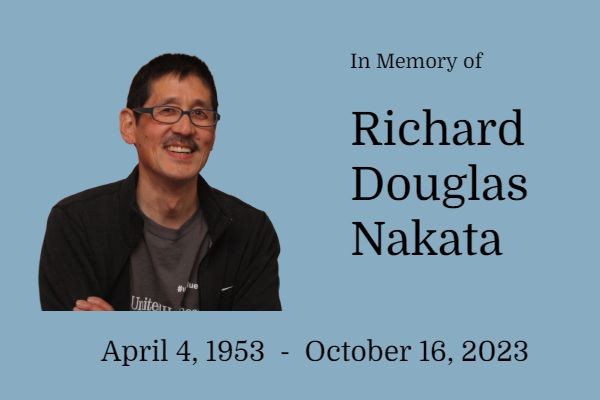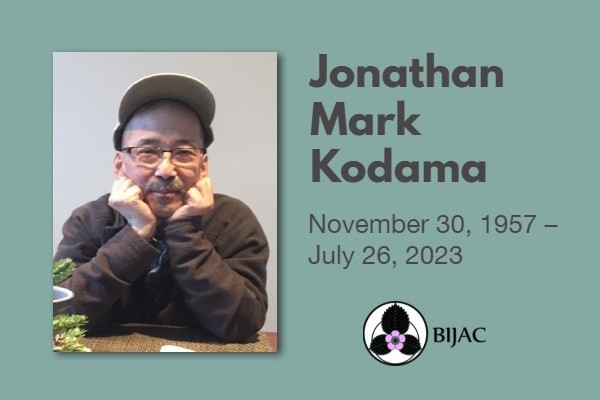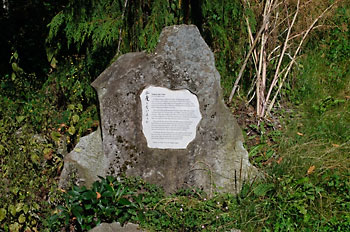 In 2002, sixty years after Bainbridge Island’s 272 Japanese Americans were sent into unconstitutional imprisonment, a small plaque was unveiled on the site of their departure to honor them and the memory of what was done to them. More than two–dozen Nikkei were among the 500 people who listened as Governor Gary Locke, Representative Jay Inslee and others spoke of their hope that the National Park Service might soon recognize the site officially.
In 2002, sixty years after Bainbridge Island’s 272 Japanese Americans were sent into unconstitutional imprisonment, a small plaque was unveiled on the site of their departure to honor them and the memory of what was done to them. More than two–dozen Nikkei were among the 500 people who listened as Governor Gary Locke, Representative Jay Inslee and others spoke of their hope that the National Park Service might soon recognize the site officially.
The Plaque Reads:
Nidoto Nai Yoni – Let it not happen again
On the morning of March 30, 1942, 227 Bainbridge Island men, women, and children–most of them United States Citizens–were escorted by armed soldiers to the Eagledale ferry landing. They solemnly boarded the ferry Kehloken and departed on a lonely journey with an unknown destination and fate.
They were exiled by Presidential Executive Order 9066 and Civilian Exclusion Order No. 1 because they were Nikkei — persons of Japanese ancestry. With only six days notice they were forced to hastily sell, store, or make arrangements for all of their possessions, businesses and property. They were allowed to take only what they could carry or wear.
They were the first of more than 120,000 Japanese Americans to be forcibly removed from their homes and experience three years of unconstitutional incarceration. Not all were incarcerated. Some were drafted into the military, some were unjustly imprisoned, and some moved away — but all were forbidden to remain.
We dedicate this site to honor those who suffered and to cherish their friends and community who stood by them and welcomed them home. May the spirit of this memorial inspire each of us to safeguard constitutional rights for all.
Nidoto Nai Yoni “Let it not happen again.”
 A 100–year–old Western Red Cedar that stood near the Eagledale ferry dock as Bainbridge Islanders were forced to leave their homes in 1942 — and that still stands on the site of the Memorial — was named in 2003 to the National Registry of Historic Trees by the American Forests organization. Only the second West Coast tree to earn this distinction, it is considered a living witness to an event that helped shape our nation.
A 100–year–old Western Red Cedar that stood near the Eagledale ferry dock as Bainbridge Islanders were forced to leave their homes in 1942 — and that still stands on the site of the Memorial — was named in 2003 to the National Registry of Historic Trees by the American Forests organization. Only the second West Coast tree to earn this distinction, it is considered a living witness to an event that helped shape our nation. 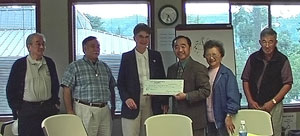 Bainbridge Island’s Rotary Club shares proceeds from its annual and enormously popular rummage sale with local groups working for the community good. In 2004 the Nidoto Nai Yoni Memorial was given a very generous $25,000 check! Thanks, Rotarians!
Bainbridge Island’s Rotary Club shares proceeds from its annual and enormously popular rummage sale with local groups working for the community good. In 2004 the Nidoto Nai Yoni Memorial was given a very generous $25,000 check! Thanks, Rotarians!  On March 30, 2004 nine local Nikkei wielded ceremonial shovels on the sixty-second anniversary of the Islanders journey into exile, to break the ground for the Nidoto Nai Yoni Memorial and the neighboring Joel Pritchard Park. Pritchard’s son, Frank, and former Secretary of State and Islander Ralph Munro were joined by nearly 120 people to witness the kick–off of the private fund–raising effort for raise the $4 million needed to complete the Memorial.
On March 30, 2004 nine local Nikkei wielded ceremonial shovels on the sixty-second anniversary of the Islanders journey into exile, to break the ground for the Nidoto Nai Yoni Memorial and the neighboring Joel Pritchard Park. Pritchard’s son, Frank, and former Secretary of State and Islander Ralph Munro were joined by nearly 120 people to witness the kick–off of the private fund–raising effort for raise the $4 million needed to complete the Memorial.
DEDICATION SPEECH by Frank Kitamoto (click icon to listen), Transcript of Speech (PDF)
Local Master Timber Framer, John Buday of Cascade Crest Designs, designed both gates and the pavilion.
At 11:03 a.m. on Monday, March 30, 2009, the oldest surviving Bainbridge Island Japanese American, 98 year–old Fumiko Hayashida, joyfully stood in the cab of a construction backhoe as it broke ground for the long–awaited “Story Wall” for the Bainbridge Island Japanese American Memorial (BIJAM).
It was an unforgettable ending to the 67th Anniversary ceremony, commemorating the historic moment when Hayashida and 226 fellow Bainbridge Islanders departed from the Eagledale ferry landing at 11:03 a.m. on Monday, March 30, 1942, becoming the first Japanese Americans exiled to concentration camps in WWII.
Phase 2, the 272–foot long “Story Wall” — one foot for every Japanese American who lived on Bainbridge Island at the start of WWII — is the heart of the memorial project, telling a unique American story of immigration, establishment, their forced removal and return to their island home.
Designed by award–winning architect and fellow islander Johnpaul Jones and BIJAM Project Manager John Buday of Cascade Crest Designs, the gently curving wall of granite, basalt and cedar is being built on Taylor Road where the Bainbridge Islanders were escorted by armed US Army soldiers to the ferry landing.
The nearly $500,000 project was awarded to Drury Construction of Poulsbo, WA (who generously provided Fumiko Hayashida’s backhoe) and it is expected to be built by this summer. However, $300,000 is still needed to design, produce and install interpretive materials for the wall.
Still to come and yet unfunded are Phase 3, which includes a timber–framed environmentally designed interpretive center and meeting room complex ($5.7 million), and Phase 4, a 150 foot “departure pier” representing the 150 Japanese Americans who returned to Bainbridge Island after the war ($900,000).
Bainbridge Japanese–American Internment Memorial Takes Shape — Kitsap Sun article on the BIJAEM Open House. By Tristan Baurick. March 30, 2011.
Close to 600 visitors attended the hour–long ceremony. Speakers addressed the history of the Bainbridge Island exclusion experience including the journey of creating this Memorial, the healing this Memorial hopes to foster, and the honor it will bring to this community. Sallie Maron, President of the Bainbridge Island Japanese American Exclusion Memorial Association (BIJAEMA), summarized what this Memorial represents:
“Today we honor a host of qualities embodied in this Memorial Wall. First and foremost, we honor the courage and dignity of the 276 Bainbridge Islanders who lost so much and yet persevered as lights in their families, their communities, and their nation. We honor the love of a community for its neighbors and the recognition that the way we treat each other is the foundation of community. We honor the honesty of a government willing to admit a mistake and attempt to make amends. We honor the creativity and dedication of the architects, builders, designers, artists, and gardeners whose ideas and skills made this a place of beauty and inspiration. We honor the generosity of hundreds of people who have donated their time, talents, and resources to support the work of building the wall. And because of the remarkable depth and breadth of support for this project, heartfelt gratitude is embedded in every inch of the Memorial Wall.”
The Bainbridge Island Japanese American Exclusion Memorial project is being supported in part by a Preservation of Japanese American Confinement Sites Grant administered by the National Park Service, Department of the Interior.
An honored group of Bainbridge Island WWII incarceration camp survivors was present on-site with golden shovels in hand to break ground on the site 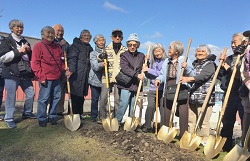 of the new Departure Deck. The Departure Deck will be located at the water’s edge to symbolize the original departure deck that led to the departing ferry Kelohken, which would carry the first Japanese Americans to be evacuated to awaiting trains in Seattle. The Departure Deck is another planned component of the Exclusion Memorial designed to evoke in visitors the sense of fear and uncertainty that was experienced by evacuees as they were forcibly removed from their homes.
of the new Departure Deck. The Departure Deck will be located at the water’s edge to symbolize the original departure deck that led to the departing ferry Kelohken, which would carry the first Japanese Americans to be evacuated to awaiting trains in Seattle. The Departure Deck is another planned component of the Exclusion Memorial designed to evoke in visitors the sense of fear and uncertainty that was experienced by evacuees as they were forcibly removed from their homes.
Built at the site of the historic Eagledale Ferry Dock, the Exclusion Departure Deck at the Bainbridge Island Japanese American Exclusion Memorial (BIJAEM) will be an evocative and poignant addition to this memorial of the first forced removal and exclusion of 120,000Japanese Americans during WWII. The 45-foot cantilevered deck at the end of the existing 276-foot Memorial Wall walk, estimated to take several weeks to complete, is currently under construction.

“Once people have walked in the footsteps of history at the Memorial Wall, tracing the steps of the first Japanese Americans in the nation to be forcibly removed in WWII, the Exclusion Departure Deck will complete their journey of discovery where our friends and neighbors left the island, facing an unknown future and fate.”
Val Tollefson, PresidentBIJAEMA
Clark Construction, LLC of Bainbridge Island was awarded the Exclusion Departure Deck Project, and funding for the project is made possible by a $187,668 National Park Service Confinement Sites Grant, in addition to generous private donations.

